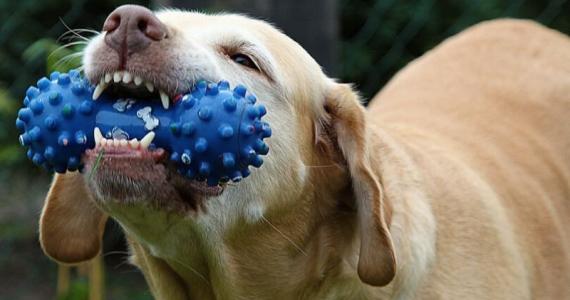One aspect of dog ownership that many owners worry about is chewing.
However, this is a natural and necessary activity. It helps to reduce stress, helps puppies learn about different textures and materials, helps relieve the irritation of teething and also exercises their teeth and jaws. Some dogs love to chew and are in the habit of chewing as often as possible. However, most dogs go through two distinct periods of chewing:
- 3-6 months when the puppy is teething. All the adult teeth are usually through by 6/7 months old.
- From 9 months when the adolescent dog is confidently investigating novel items and building jaw strength in preparation for adulthood.
As there are so many things that you don't want your dog to chew it is easier to teach him what you DO want him to chew. Make sure he has lots of safe chew toys, such as Kongs, Nylabones, sterilised and smoked bones and healthy chews. A safe chewtoy is something that either is unlikely to be destroyed or something which is specifically designed to be ingested safely. Soft plastic squeaky toys or Ragger-type tuggy toys are not appropriate chewtoys as unsupervised chewing can result in choking. Swallowing unsuitable items can cause blockages and result in surgery so safety is a vitally important factor when choosing a chewtoy.
Some chewtoys can be made even more appealing by stuffing them with portions of your dog's regular diet along with extra tasty titbits, such as cheese, apple and carrot. One of the best and most popular chewtoys are Kongs. These are round rubber pyramids which you can stuff with all sorts of goodies. Then your dog has to figure out how to get them out of the toy by bouncing, squashing and rolling the Kong around. The better you are at stuffing the Kong, the more effort your dog will have to use to empty it.
You can even give your dog a frozen Kong which takes some emptying! Be inventive - spread peanut butter around the inside to act like an edible glue for the other titbits, such as vegetable, fruit, pasta, fish, chicken and biscuits. And make sure that you put something extra smelly and tasty in the top end, so that even when everything else has been eaten, the dog is still motivated to work at the toy.
When you first give your dog a stuffed Kong make sure that the treats fall out of it very easily while your dog learns that the toy is fun. If you make it too hard to begin with, they may lose interest.
One of the most useful exercises to teach your chewing dog is 'take it' and 'leave'. This exercise is great for preventing possessiveness, avoiding ripped trouser hems and untied shoelaces, and retrieving your underwear before the pup dashes out the back door with it! These following cues are easy to teach:
- Hold a titbit in your hand and show it to your dog.
- The dog will try to take it, but you should hold it tightly and say 'Leave!', once, in a quiet, firm voice. As you do this hide the food in your hand so that it disappears from sight.
- Keep your hand still and when your dog stops trying to touch the food, with his mouth or paws, you can immediately say 'Take it!' and give them the titbit. Remember when you first say 'Leave' that your dog has no idea that this means anything, so don't get cross when they continue to try to get the titbit.
As well as chewing items that they've been given, your dog may also help themself to interesting and exciting items that they find for themself. The golden rule is not to chase the dog. Instead, if the object is of no value and will not harm them, for example a used tissue, you should simply ignore the dog. Your dog will soon learn that if the item is not of any importance to you then they won't get your attention if they steals it.
However, if it is valuable or harmful, swap it for something else that the puppy really likes, e.g. offer them a piece of cheese. In this situation it's important to understand that the dog is being rewarded for leaving the stolen object, not for stealing it. Once the dog has learned what the cues mean, you can use the 'Leave!' cue whenever your dog has something that they shouldn't, as well as when you want them to drop their toy so that you can throw it for them again. Use the 'Take it!' cue for anything that you want them to hold. Very handy for teaching a good retrieve, and achieving an excellent basis of understanding with your dog.
Supervision is always the key, but we all have to leave our dogs at times. If your dog is enjoying chewing fixtures and fittings a little too much and tending to choose them over whatever toys you have left him, the correct course of action is to deny them access until they have forgotten the joys of, for instance, the skirting board! You can either block it off with wire mesh, put them in another more dog-proof room - see our advice on crate training.
Remember, telling your dog off for indulging in what is essentially a natural behaviour when left alone is not only unkind but can be counter-productive and lead to separation anxiety.

